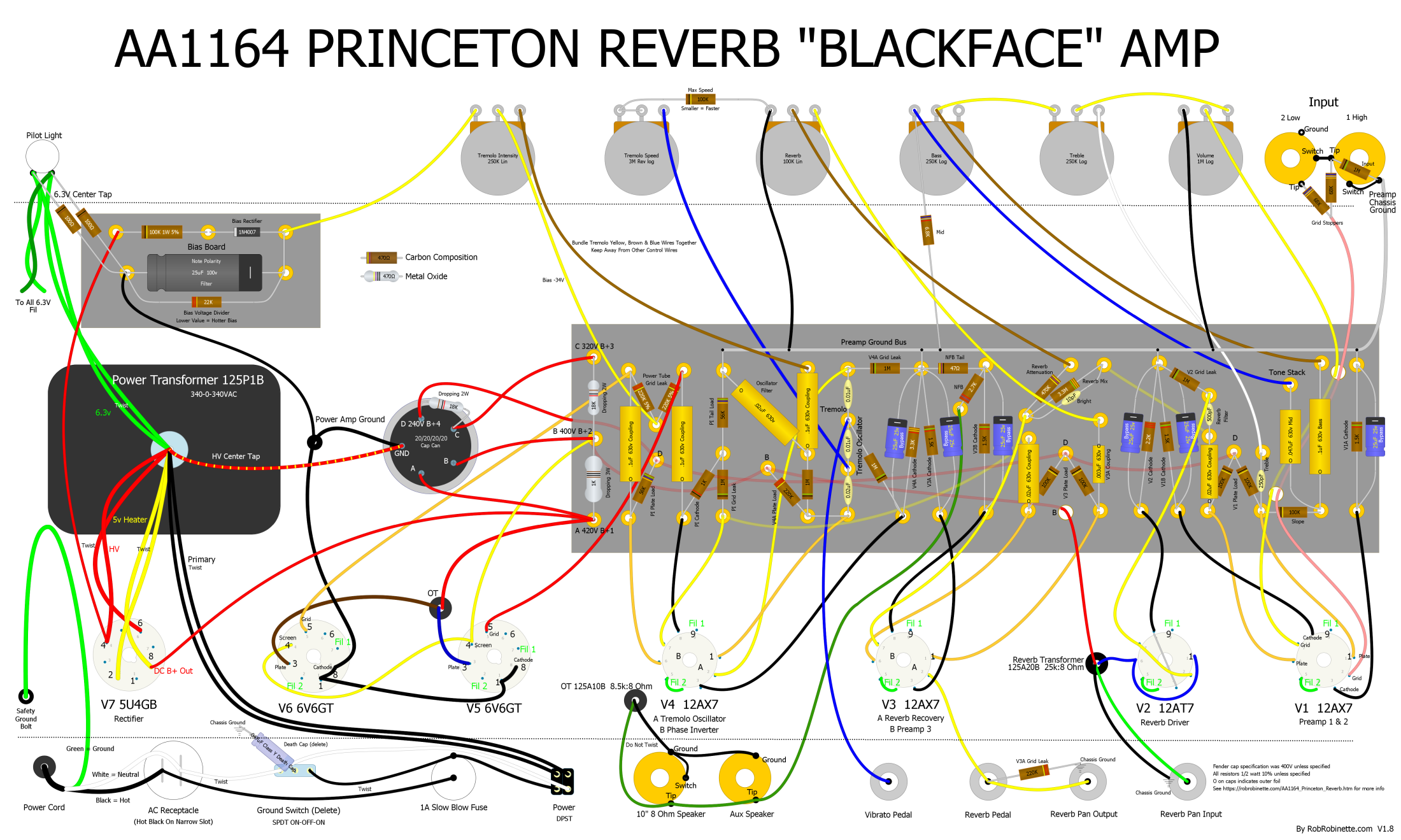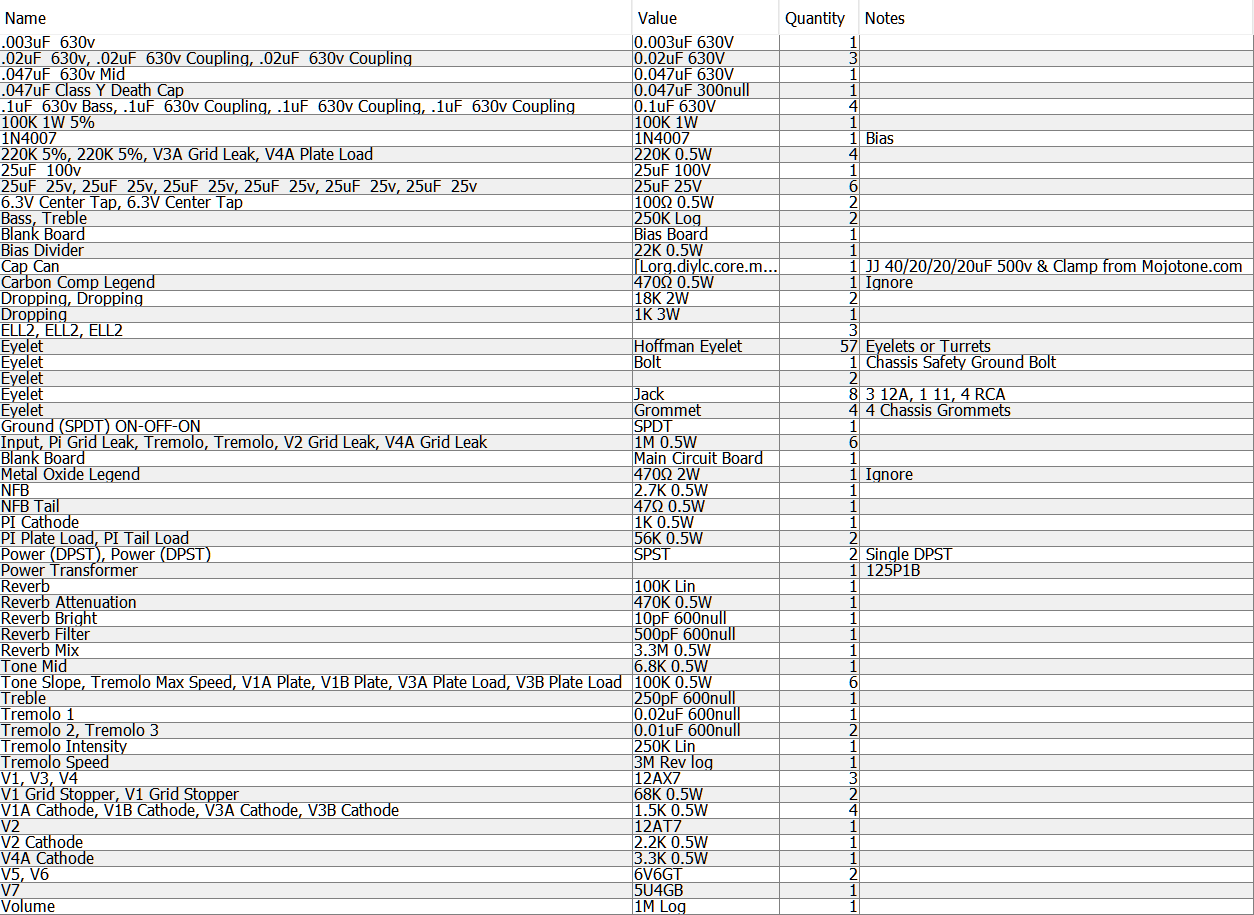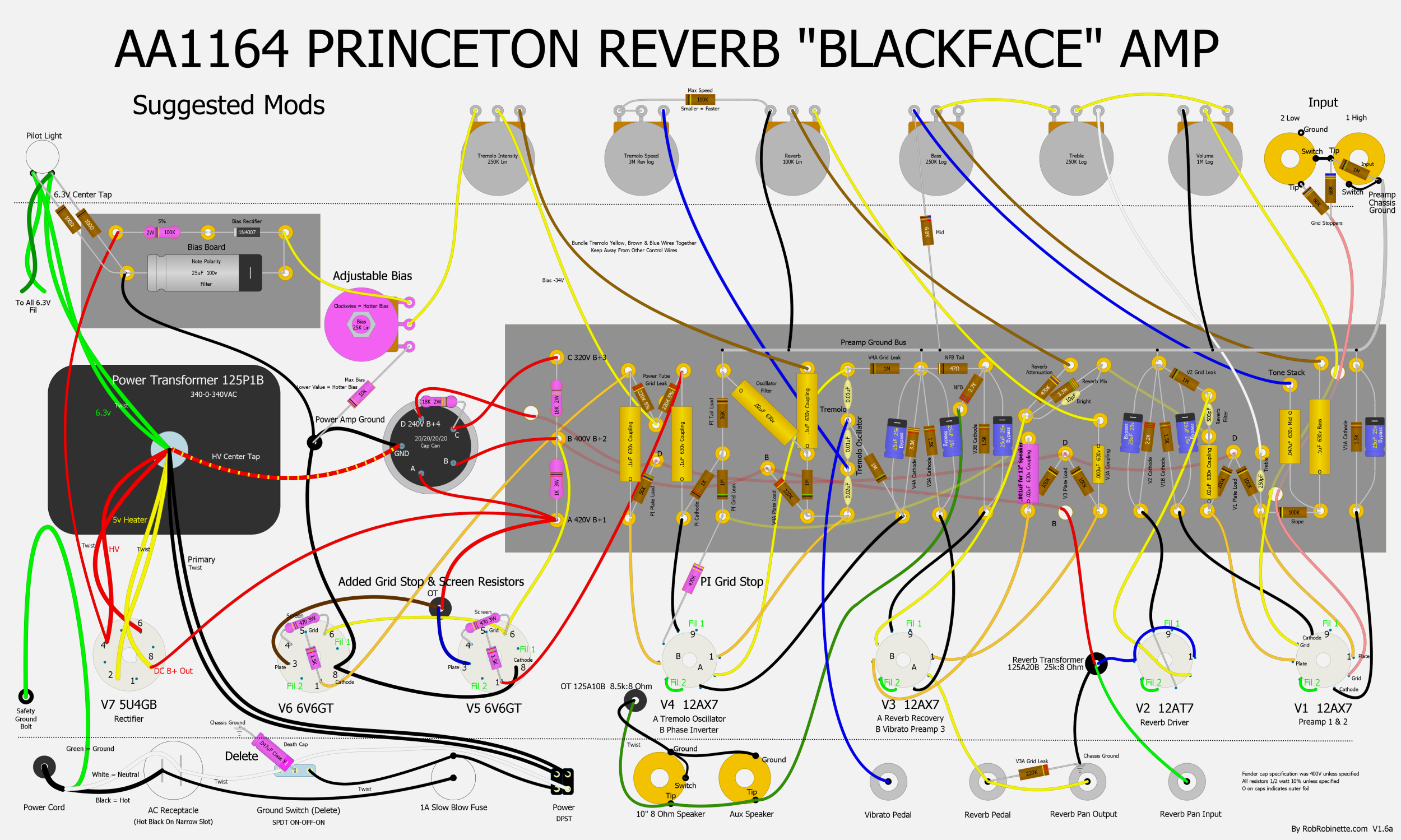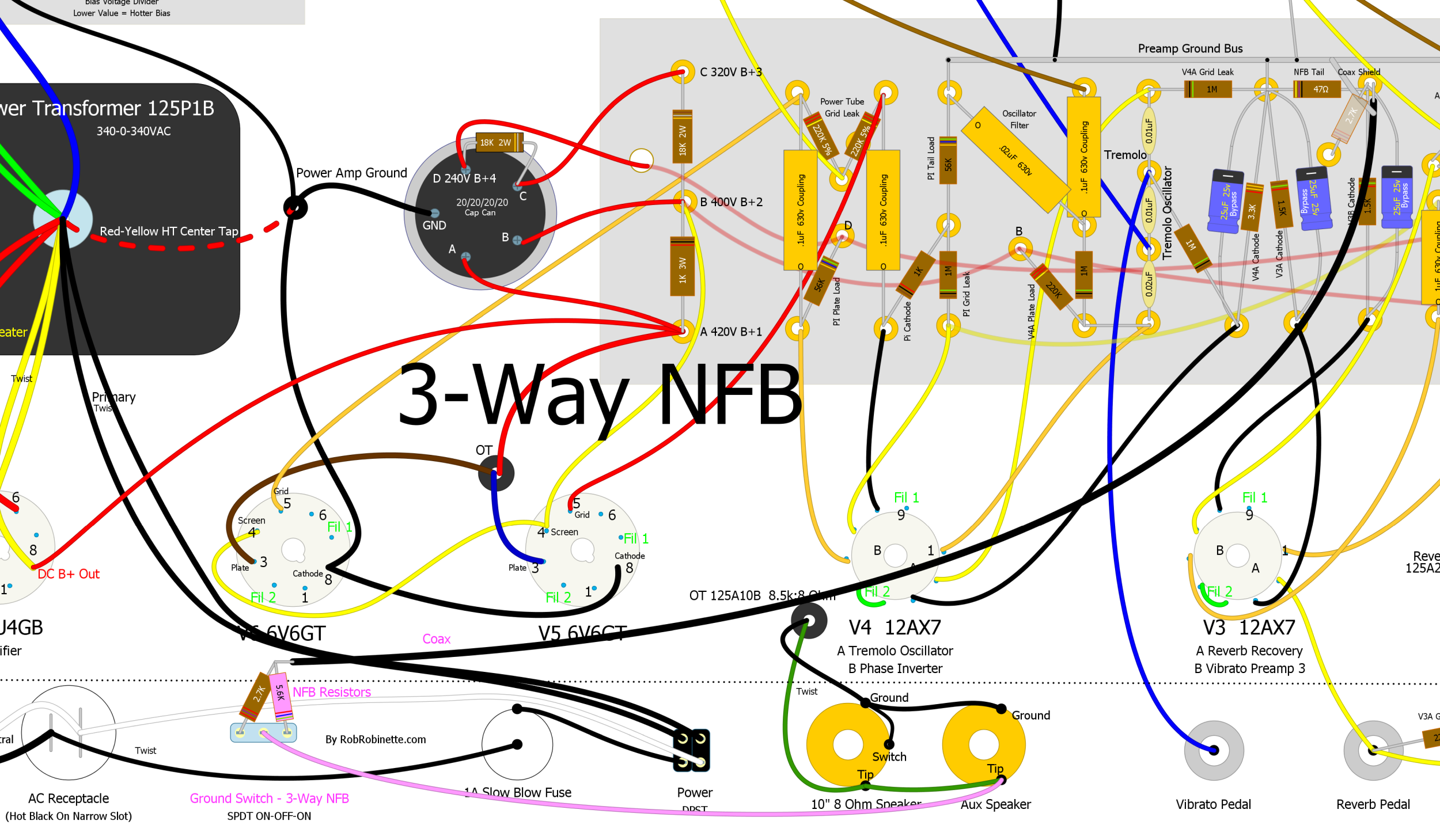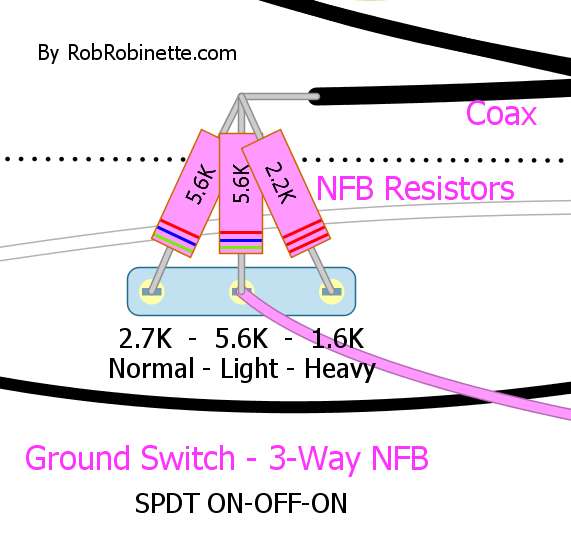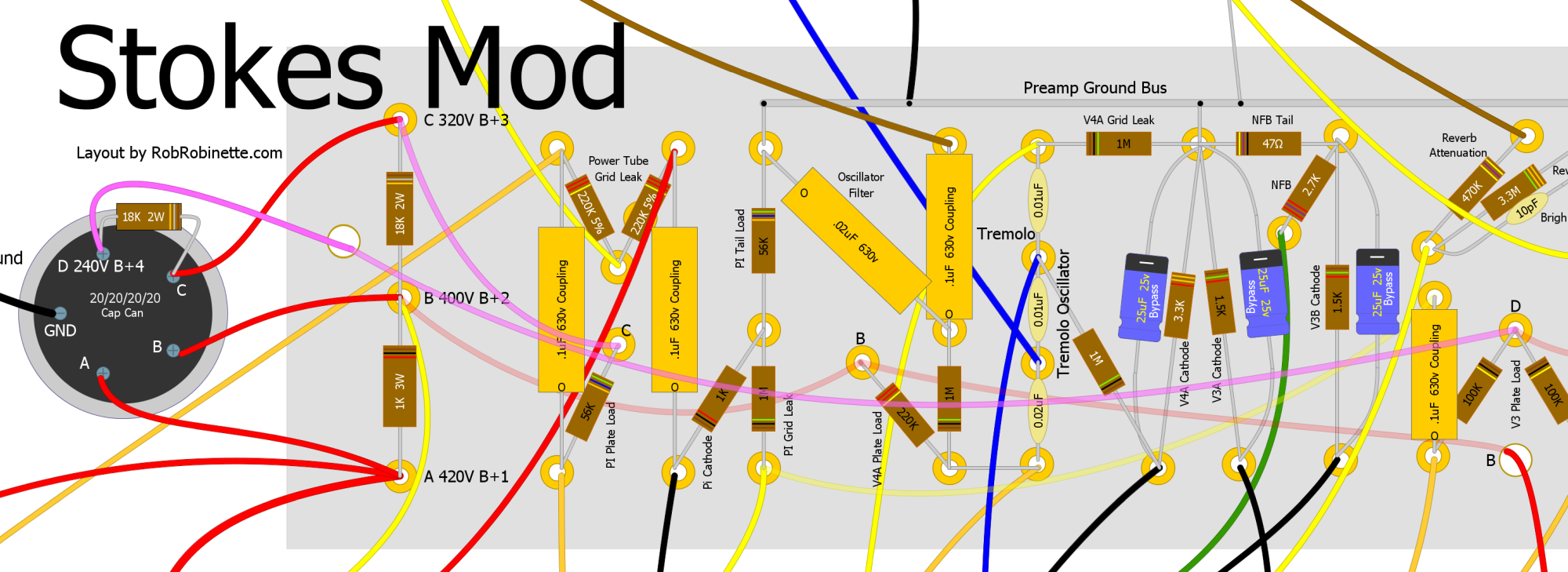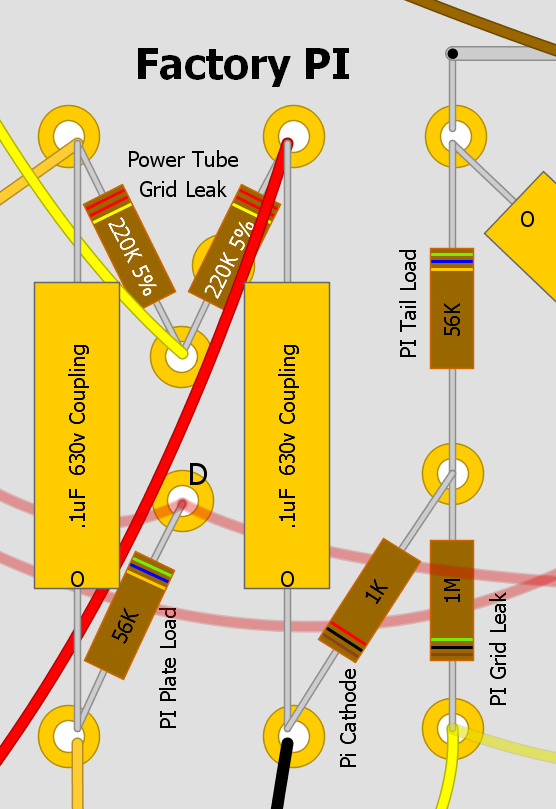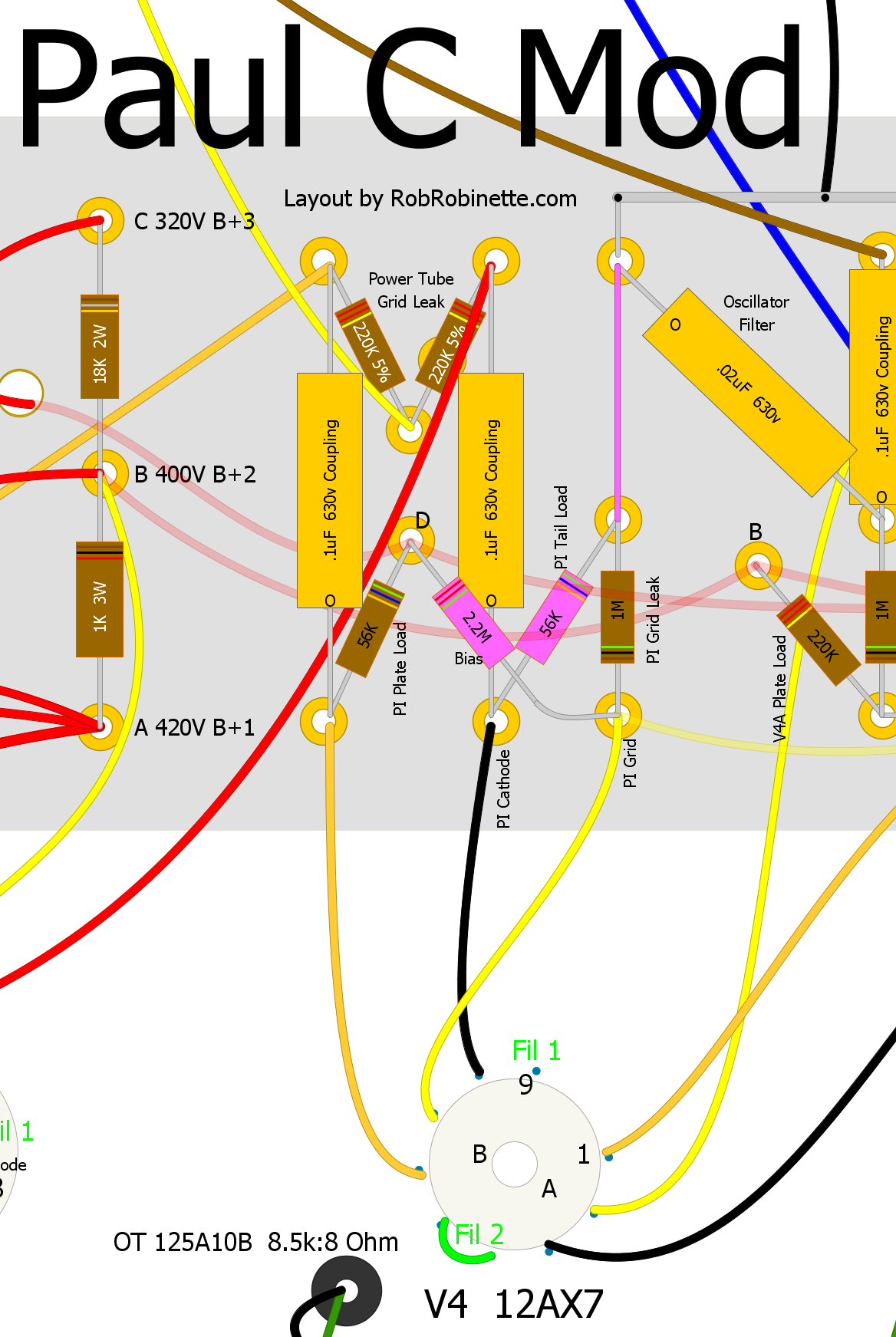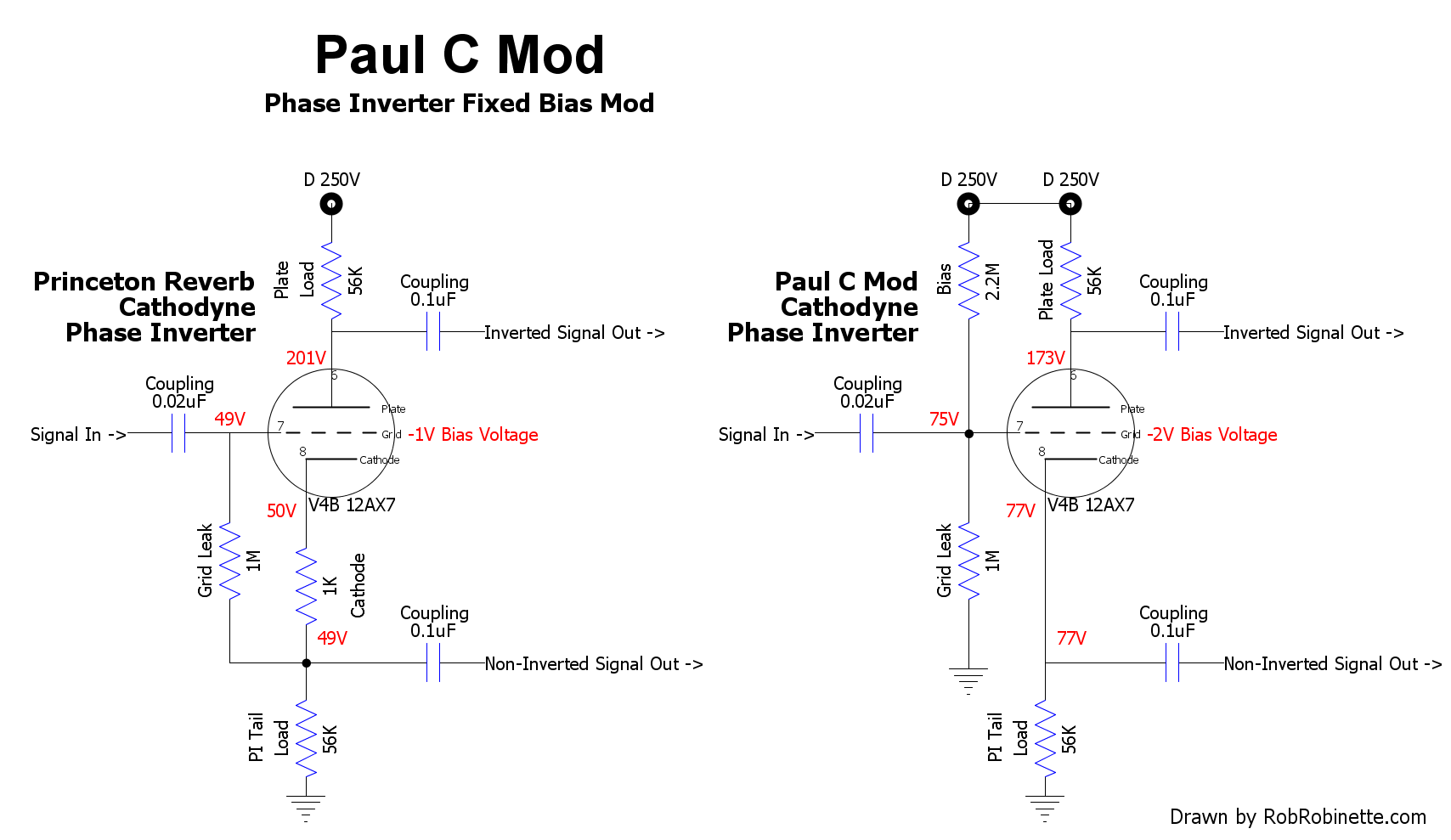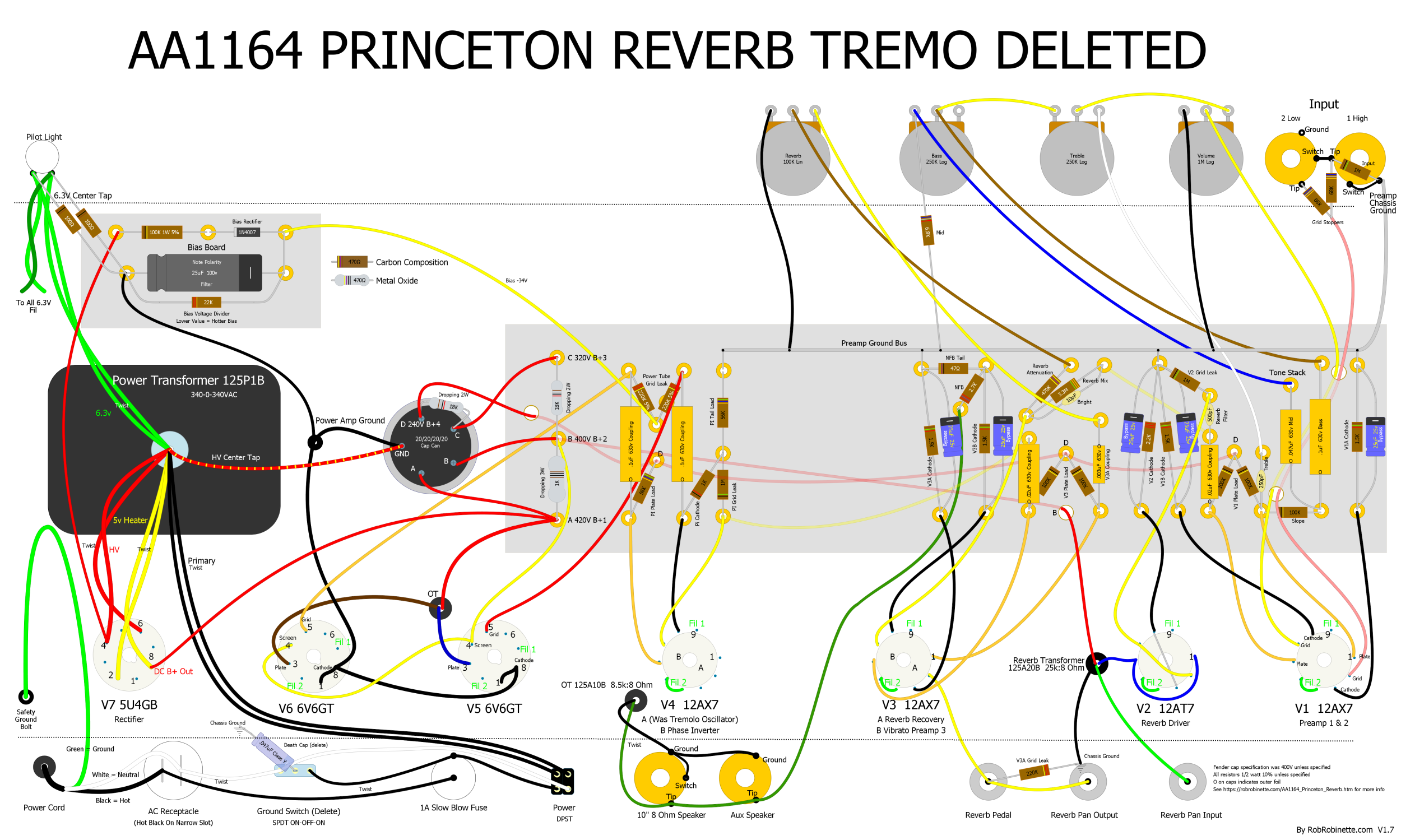AA1164 Blackface Princeton Reverb
By Rob Robinette
Have comments or corrections? Email rob at: robinette at comcast dot net
The 1964 blackface AA1164 Princeton Reverb is an iconic compact amp that can do just about anything. It's a very popular blackface amp kit sold by Mojotone.com and other kit makers but it is an advanced build so I don't recommend it as a first amp build but the simplified Princeton Reverb with reverb and tremolo deleted can be a first build. The Princeton Reverb preamp is 100% blackface with three fully bypassed preamp gain stages so there's lots of overdrive to be had.
Table of Contents
Princeton Reverb with reverb and tremolo deleted (three preamp gain stages so very different than blackface Princeton)
Princeton Reverb Micro with reverb and tremolo deleted (1 watt 12AU7 true push-pull power tube)
Princeton Reverb with tremolo deleted
Original Fender Princeton Reverb Layout
Original Princeton (non-reverb) Layout (only two preamp gain stages)
Blackface Princeton Reverb
High Resolution Annotated Layout
Every component function is listed. Click on the layout to see the high resolution layout. Download the pdf here and the DIYLC file here. Download the main circuit board Hoffman file and the bias board Hoffman file and upload them to HoffmanAmps.com DIY File Analyzer and Doug will make eyelet or turret boards for you for a very reasonable price.
Annotated Schematic
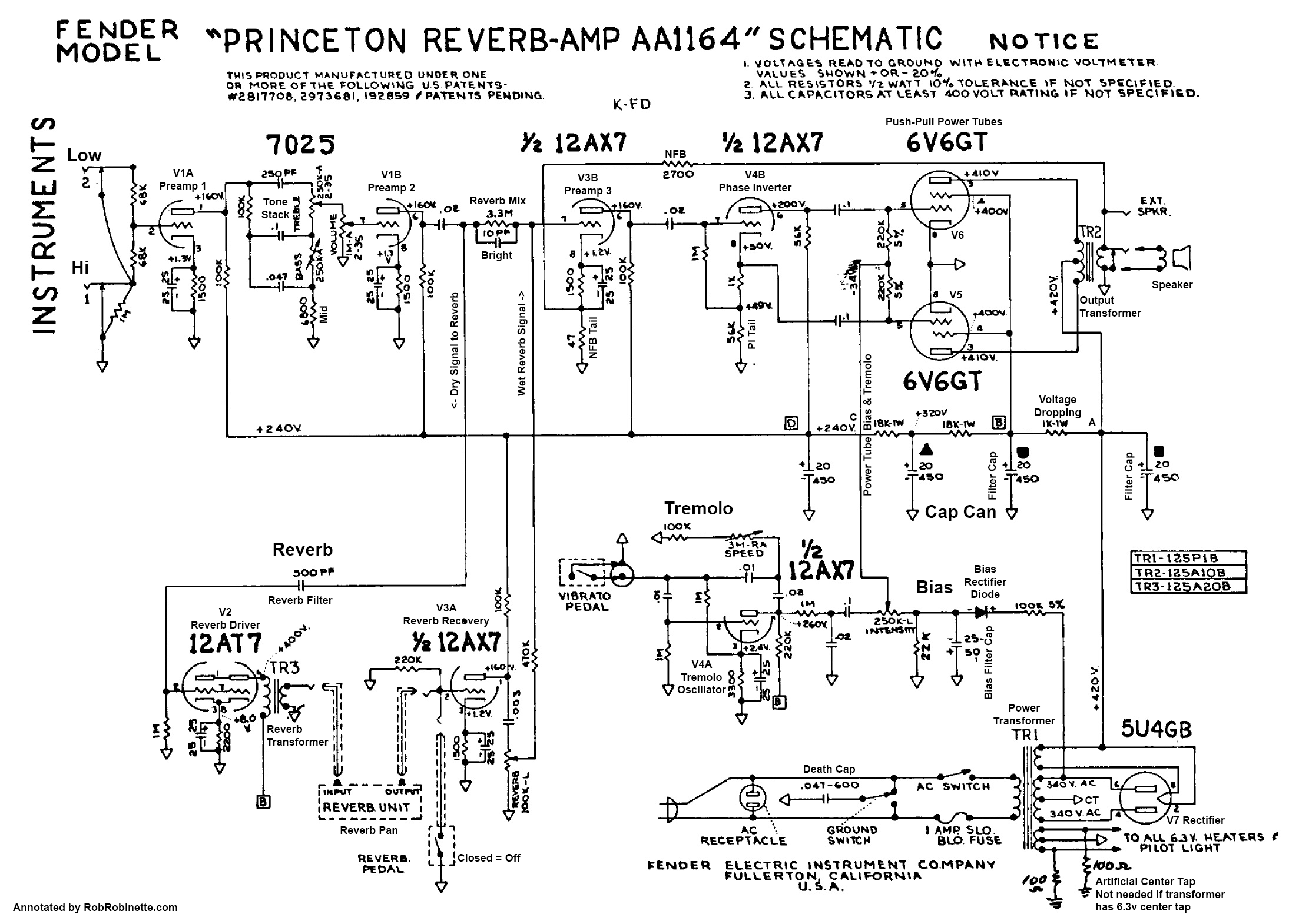
Signal Path Through Amp
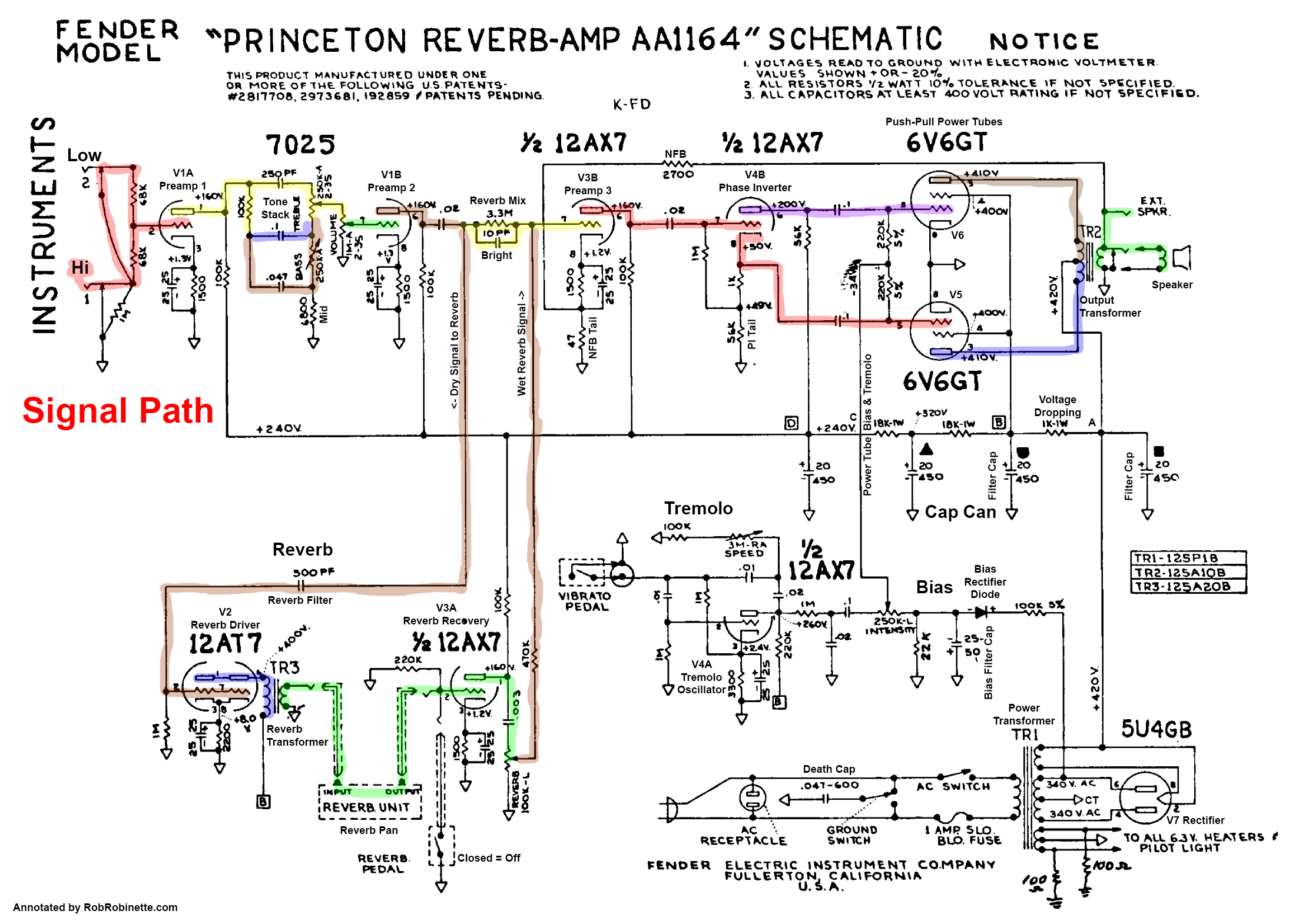
The signal flow colors match between the schematic above and layout below to help you follow the flow.
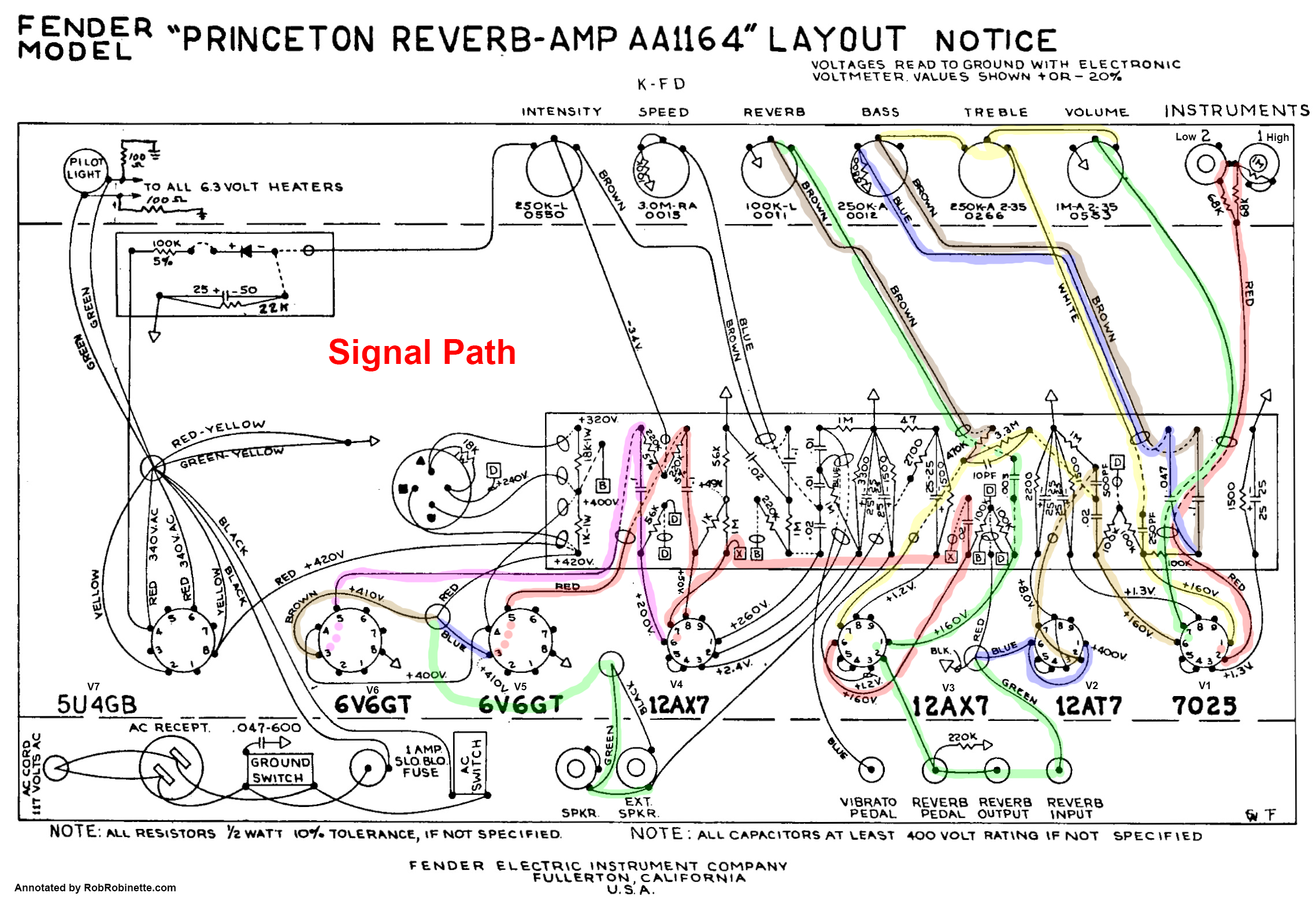
The AA1164 Princeton Reverb is a 2x6V6 push-pull amp that's very similar to the AB763 blackface amps except for these major differences:
The Princeton Reverb uses a cathodyne phase inverter instead of the AB763's long tail pair (LTP). The cathodyne phase inverter is the primary cause of the tone differences between the Princeton Reverb and other blackface amps. The cathodyne adds a gain of less than 2 whereas the AB763's long tail pair adds about 50% of the gain of a typical single triode gain stage (gain of around 30). The cathodyne is notorious for funky double frequency blocking distortion when pushed hard into overdrive. Adding a 470k phase inverter grid stop resistor goes a long way toward correcting the overdrive issues and doesn't affect the clean tone at all. I highly recommend this simple mod for all Princeton and Princeton Reverb models.
The Princeton Reverb uses no choke in the power supply so it's a little softer with more power supply sag and compression.
The Princeton Reverb uses power tube bias wiggle tremolo versus the AB763's preamp signal tremolo. Since bias wiggle tremolo doesn't load down the preamp signal like the AB763's signal tremolo, the guitar signal flowing into the Princeton Reverb's third preamp gain stage is stronger and helps make up for the no-gain phase inverter. Many people prefer the Princeton Reverb's bias wiggle tremolo but it does have a downside in that if you bias the power tubes too hot you will lose some tremolo intensity. The Princeton Reverb was biased pretty cool from the factory and sounds great so don't fret about this limitation.
The Princeton Reverb has no power tube grid stopper or screen resistors just like the 5E3 Deluxe.
Power filtering comes by way of a 20/20/20/20uF cap can. The JJ 40uF/20uF/20uF/20uF 500v cap can from Mojotone is a good replacement/upgrade.
Suggested Speaker: Weber and I recommend their 10F150T (8 ohm, 25 watts, light dope) for Princeton Reverbs.
Weber Note:
If
you use no pedals for dirt and you want the speaker to break up a little: 10F150T,
8 ohm,
25w,
light dope
If
you use pedals for dirt or you want the speaker to stay cleaner: 10F150T,
8 ohm,
50w,
light dope
Weber on Dope:
Put simply: the higher gain you use, the more dope you should have on your speaker.
Bill of Materials
You'll also need a power, output and reverb transformer, chassis, reverb pan and cables, cab, speaker and power cord.
AA1164 - AB763 Differences
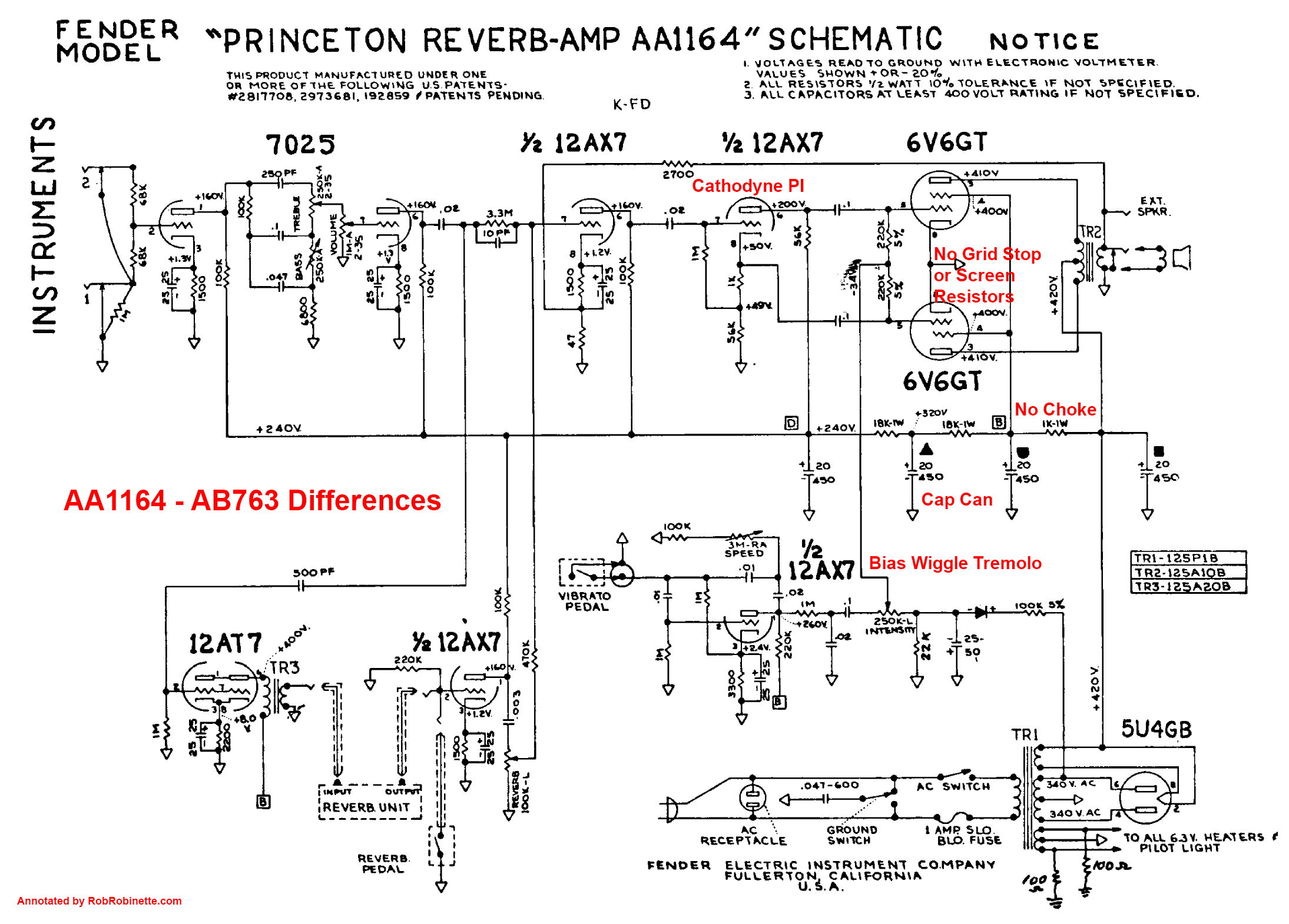
Major differences between the blackface Princeton Reverb and blackface AB763 amps are the cathodyne phase inverter, bias wiggle tremolo, lack of power supply choke, lack of power tube grid stop and screen resistors and the use of a cap can for the power supply filter caps. The cathodyne phase inverter is responsible for most of the tone difference.
Suggested Mods
These are standard Princeton Reverb upgrades (shown in pink) that are universally praised. Adjustable bias is added, phase inverter grid stop resistor added, power tube grid stop and screen resistors are added and the "death cap" is deleted. The bias pot has the authority to bias 6V6 and 6L6 tubes. Be advised though, if you bias too hot you will lose some tremolo intensity. The phase inverter grid stop resistor mellows the phase inverter's overdrive behavior by preventing nasty sounding double frequency blocking distortion--I highly recommend this mod for all Princeton Reverbs. The grid stop and screen resistors help the power tube circuit deal with heavy overdrive and sweeten the overdrive tone. This mod is a must if you want to run 6L6 or 5881 power tubes but it makes the sockets incompatible with EL34 tubes which need socket pins 1 & 8 tied together.
A 12 inch speaker can sometimes have too much low end so reducing the phase inverter input coupling cap from .1uF down to the Fender blackface standard .001uF can really help.
I also recommend upgrading the four voltage dropping resistors' watt rating (two at far left of circuit board, one on the cap can and one on the bias board) to the values shown in the layout above.
Upgrading all of the plate load resistors to 2 watt resistors will reduce amp hiss and increase longevity.
For slower and deeper tremolo see the Tremolo Depth and Slow Mod below.
The "death cap" should be deleted but if you insist on keeping it then replace the cap with a $1 Kemet 900 Series .01uF 400VDC 250VAC Class Y safety capacitor.
Replacing the three resistors on the input jacks with 1 watt metal film resistors can significantly reduce amp hiss.
If you need more clean headroom I recommend an upgrade to an efficient 12" speaker. Most non-Alnico 12" speakers will fit into the Princeton Reverb cab.
Examples of Quiet Modern Princeton Reverb Build
Lead dress in amps with reverb and tremolo is very important to prevent hum, oscillation and instability. This amp is a solid build and very quiet.
Princeton Reverb Chassis By Marcus Albrecht
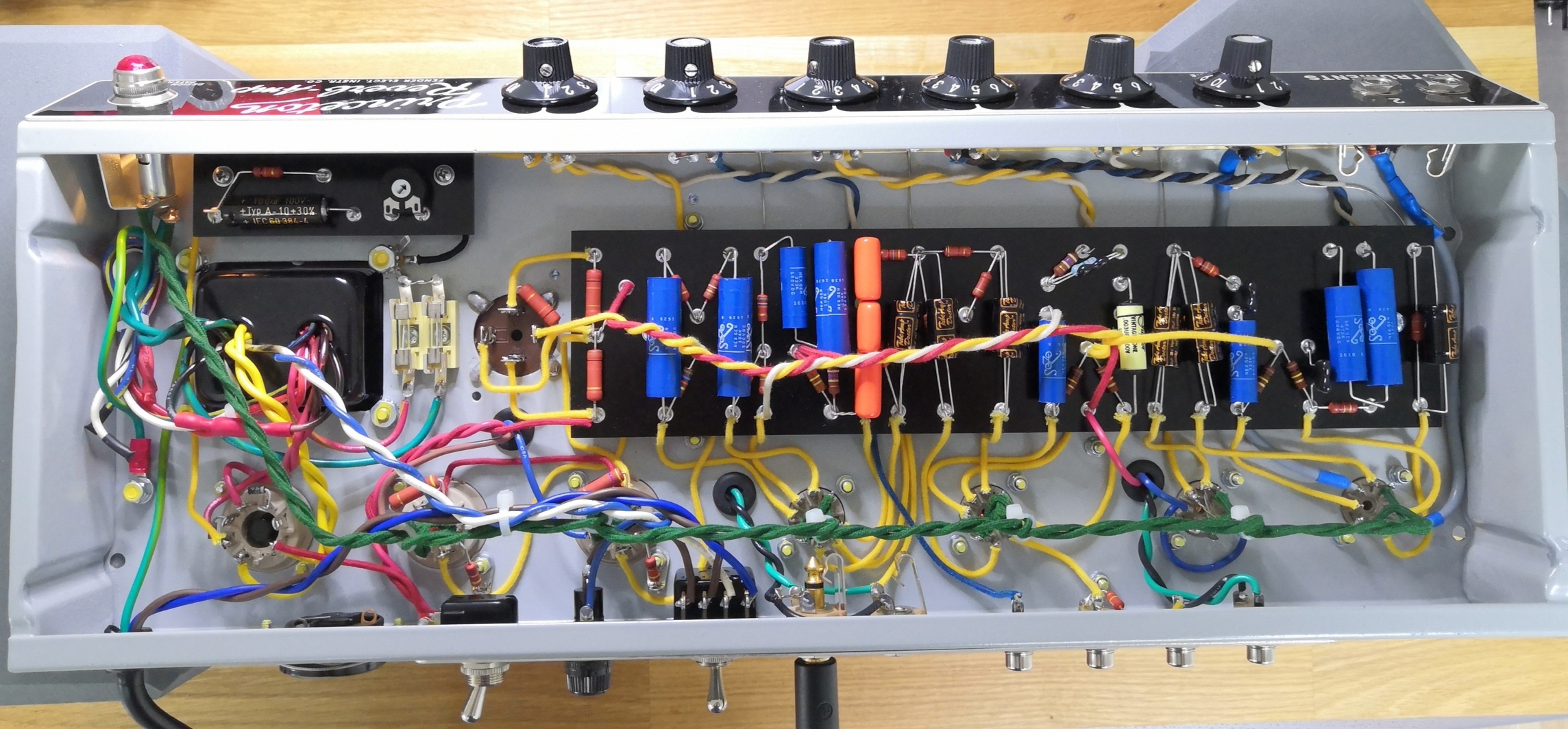
Pay close attention to routing the tremolo's control and tube socket leads. They carry a powerful signal that can interact with nearby leads and components. This is a beautiful build. Marcus is quite the photographer too.
More Princeton Reverb Pics
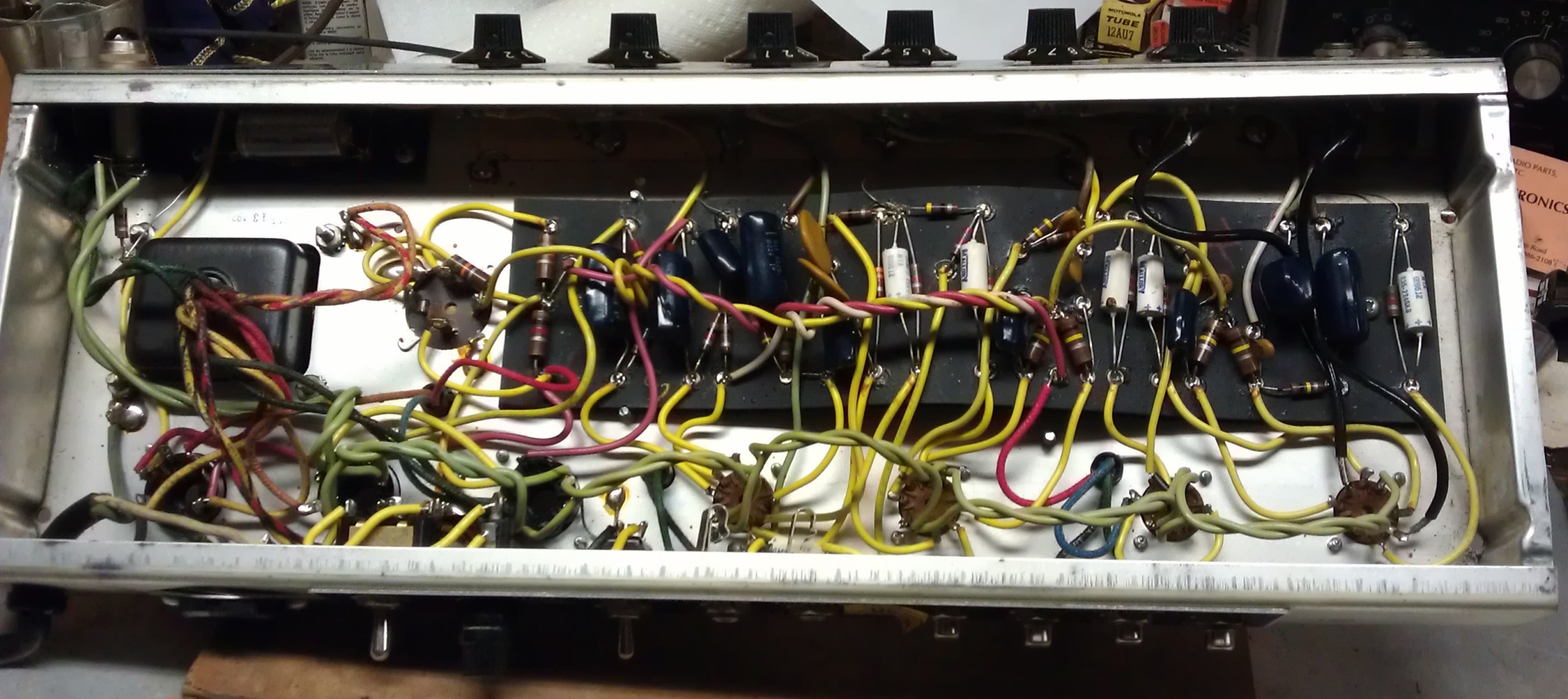
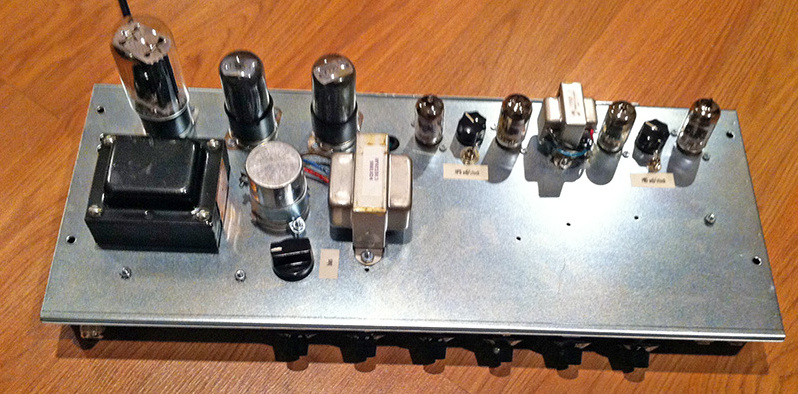
3-Way NFB Switch Using the Old Ground Switch
You can use the unneeded Ground Switch to give you 3-way negative feedback of: Normal/None/Light or Normal/Light/Heavy
You can leave the original 2.7k NFB resistor in place or remove it. Wire the Ground Switch as shown in the layout below. Run the NFB wire from the Aux Speaker jack to the Ground Switch center terminal. Keep this wire down close against the chassis corner to reduce noise pickup. Then connect a 2.7k and 5.6k resistor as shown and solder to the Ground Switch's two outside terminals. Feel free to try your own NFB resistor values. Use coax to run the connection from the two NFB resistors back to the original NFB resistor's upper eyelet as shown below. Ground only one end of the coax to prevent a ground loop. The Ground Switch is a SPDT ON-OFF-ON switch.
3-Way NFB Switch installed in place of the Ground Switch. The switch center position is no NFB, the 2.7k resistor will give you normal NFB and the 5.6k resistor will give you half of normal NFB.
Another NFB Switch Configuration
Some people find "No NFB" too loose and hairy to be of use to them. If you don't like the "No NFB" position you can use this arrangement of resistors to give you "Normal", "Light" and "Heavy" NFB options. The center position uses only the 5.6k resistor for "Light" NFB (half of normal NFB). The left position parallels the two 5.6k resistors for factory or "Normal" 2.7k of NFB resistance. The right position parallels the 5.6k and 2.2k resistors for 1.6k of "Heavy" NFB resistance (twice normal NFB).
Tremolo Depth & Slow Mod
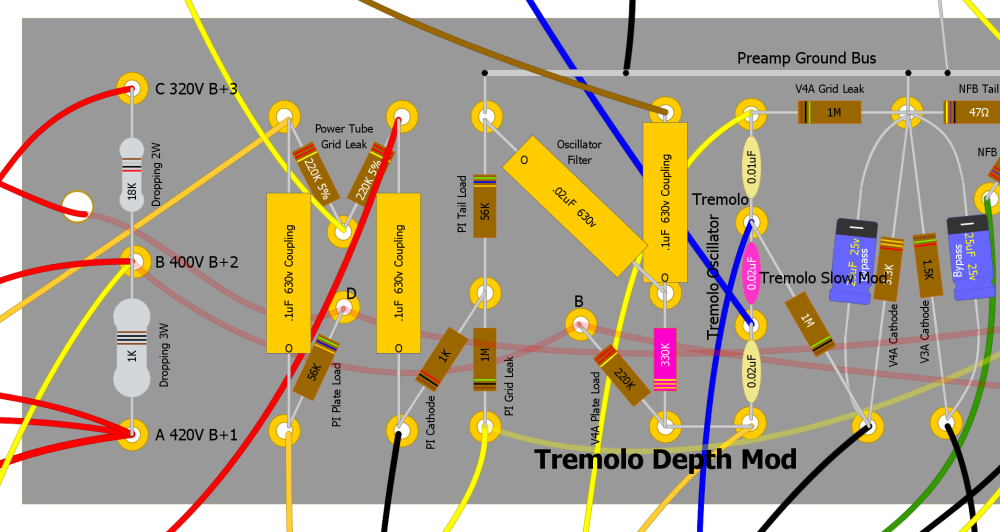
Replacing the 1M tremolo oscillator resistor with a 270k to 560k 1/2 watt resistor (highlighted in magenta above) will deepen the tremolo. Replacing the middle tremolo oscillator cap with a .02uF cap will slow the tremolo.
I don't really recommend the following mods but they are available if you really need to change the character of the little amp:
If you need more clean headroom and volume than what an efficient speaker can do then the "Stokes Mod" is an easy way to get it. The phase inverter is powered by the "D" power node with only 240 volts on tap. The Stokes Mod changes the phase inverter's power source to the unused "C" power node located at the extreme upper left of the circuit board. The C power node has 320 volts to give the phase inverter a larger signal swing before distortion begins for added headroom. This mod is often combined with the Paul C Mod in the next section. The Stokes Mod is a good mod for people who like to run 6L6 or 5881 power tubes because the phase inverter will have more voltage swing to more properly drive the big power tubes. When used with 6V6 power tubes the Stokes Mod will shift the balance between preamp and power tube distortion toward the power tubes which you may or may not prefer.
The Stokes Mod
The two pink wires are the Stokes Mod: One connects the C power node (top left circuit board) to the top of the 56k phase inverter plate load resistor and the other runs from the cap can D power node to the V3 plate load resistors. Compare this wiring to the factory wiring in the layout at the top of this page.
The Paul C Mod changes the cathodyne phase inverter from cathode bias to fixed bias to offer more clean headroom and give a more balanced output. You will get a more balanced phase inverter output but the decrease in sweet sounding even order harmonics will sterilize the tone a little. This is one of the most "didn't like it so I reversed it" mods for the Princeton Reverb.
The mod creates a fixed bias on the phase inverter grid by creating a voltage divider with the 2.2M Bias resistor and 1M Grid Leak. If the phase inverter power node is around 250v the grid voltage after the divider will be +75v. The cathode will be at an even higher voltage of around +77v due to the 56k PI Tail Load resistor so the difference between grid and cathode results in a fixed negative bias voltage of around -2v. This leads to a more balanced bias point and reduces harsh "double frequency" overdrive created by excessive plate clipping.
Factory phase inverter and the Paul C Mod. Remove the 56k PI tail load resistor and replace it with a jumper. Remove the 1k PI cathode resistor and replace it with the 56k resistor removed in the previous step. A 2.2M bias resistor is added and connects to the "D" power node at the top of the 56k PI plate load resistor to the PI grid. The PI Plate Load and 2.2M resistor can alternatively be connected to the "C" 320V power node at the upper left corner of the circuit board for even more clean headroom (Stokes Mod).
The Paul C Mod can be applied to any cathodyne phase inverter not just the Princeton Reverb. The Paul C Mod's 2.2M bias resistor forms a voltage divider with the 1M grid leak to set the fixed bias voltage at 75v. The grid leak resistor is grounded and the cathode resistor is not needed so it is deleted.
Other Mods
A GZ34 rectifier tube will raise amp voltages, stiffen the power supply for less sag & compression, tighten up the bottom end and add a little clean headroom. It will stress the Princeton Reverb's underrated power transformer.
Upgrading the first filter cap section to 40uF will slightly tighten up the amp's bottom end and reduce "fartiness". You can simply add a 20uF cap from the cap can's A terminal to the "Power Amp Ground" to parallel the existing 20uF cap can A filter. This JJ 40uF + 20uF + 20uF + 20uF cap can from Mojotone is a great upgrade or replacement cap can.
The Princeton Reverb can run 6L6 power tubes but it puts a strain on the underrated power and output transformers. You'll also get much less power tube overdrive because 6L6s can take a much larger signal on their grid before distortion begins. If you must run big bottle tubes I recommend 5881s and the use of a GZ34 rectifier, or even better, a solid state rectifier plug-in like the Weber Copper Cap to help meet the heavy power demand of the big tubes. Upgrading the first filter cap section as mentioned in the previous paragraph will also help.
The AllenAmps.com TO26 is a drop-in upgrade output transformer that is designed for 6V6, 6L6 and EL34 power tubes. The AllenAmps.com TP25 power transformer is also a drop-in upgrade that is designed to power 6V6, 6L6 and EL34 power tubes. If you are in Europe then the Tube Amp Doctor Princeton Reverb High Power power transformer is a good drop-in upgrade to run 6V6,6L6 and EL34 power tubes. If you really want to run 6L6 tubes in your Princeton Reverb then upgrading the power and output transformers is the way to go. The Deluxe Reverb output transformer is also a drop-in replacement that will reduce compression, add some low end and add output power. It really helps with 6L6 tubes too.
Delete Tremolo
Deleting tremolo only frees up a couple of inches of circuit board, half of V4 and deletes two control pots. Download the layout pdf and DIYLC file.
Original Princeton Reverb Fender Layout
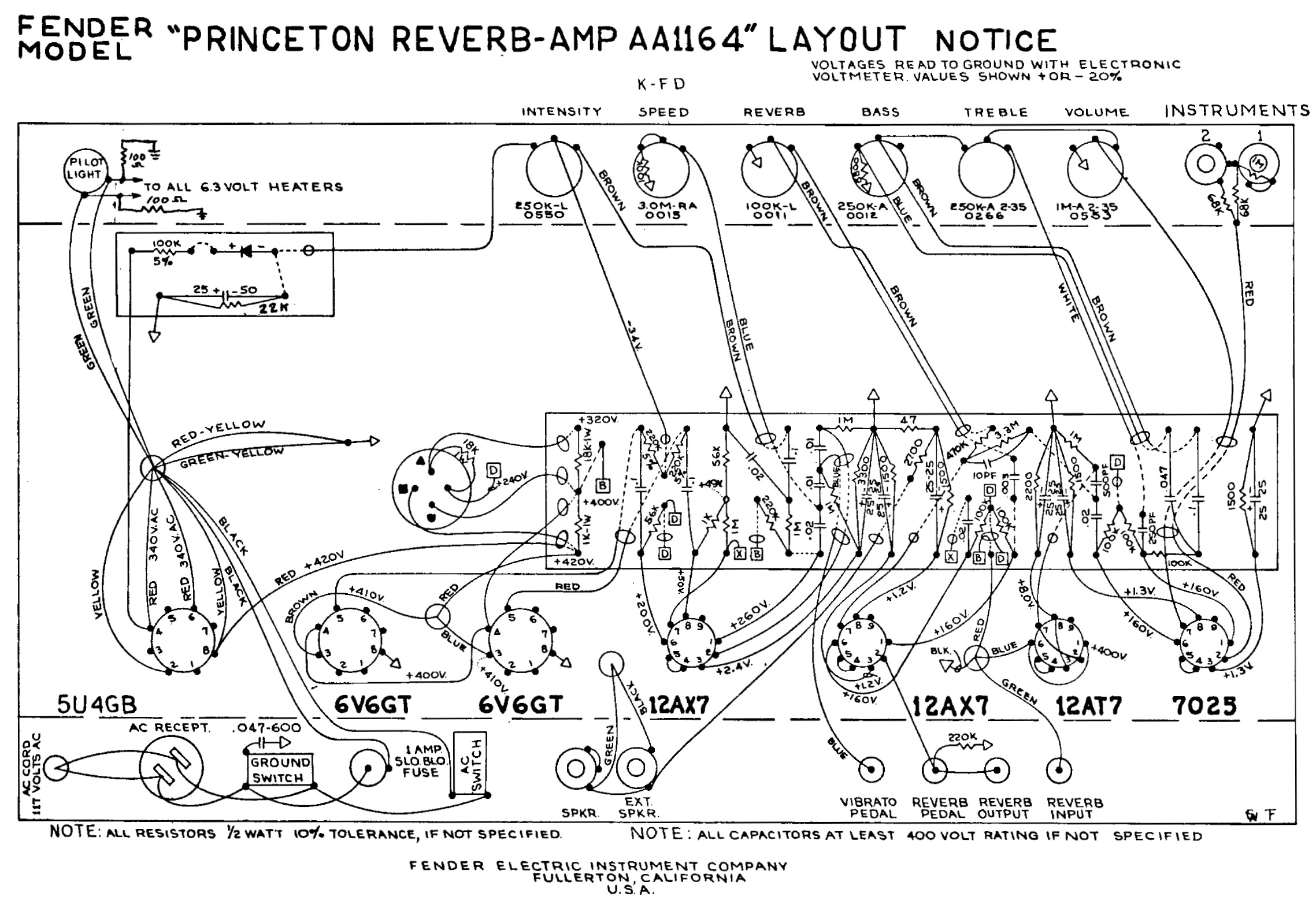
The No-Reverb Blackface Princeton
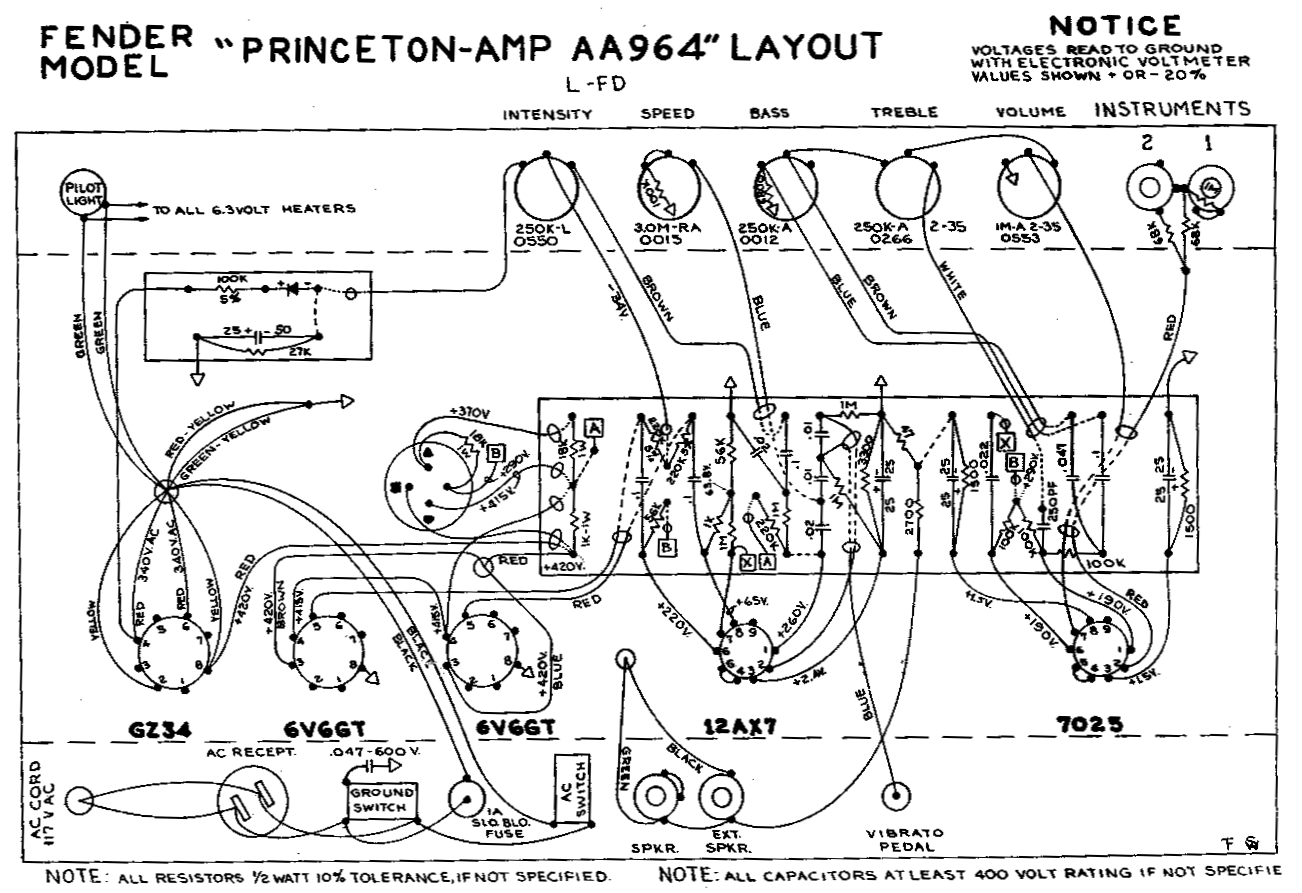
The non-reverb Princeton has only two preamp gain stages versus the Princeton Reverb's three so they are very different amps. You can delete the tremolo circuit to free up a triode to add a Princeton Reverb type third preamp gain stage. If you do this the signal coming from the second gain stage needs to be attenuated to prevent a too hot preamp signal. The Princeton Reverb's 3.3M Reverb Mix resistor forms a voltage divider with a 470k Grid Leak resistor to attenuate the signal from the second gain stage by 88%.
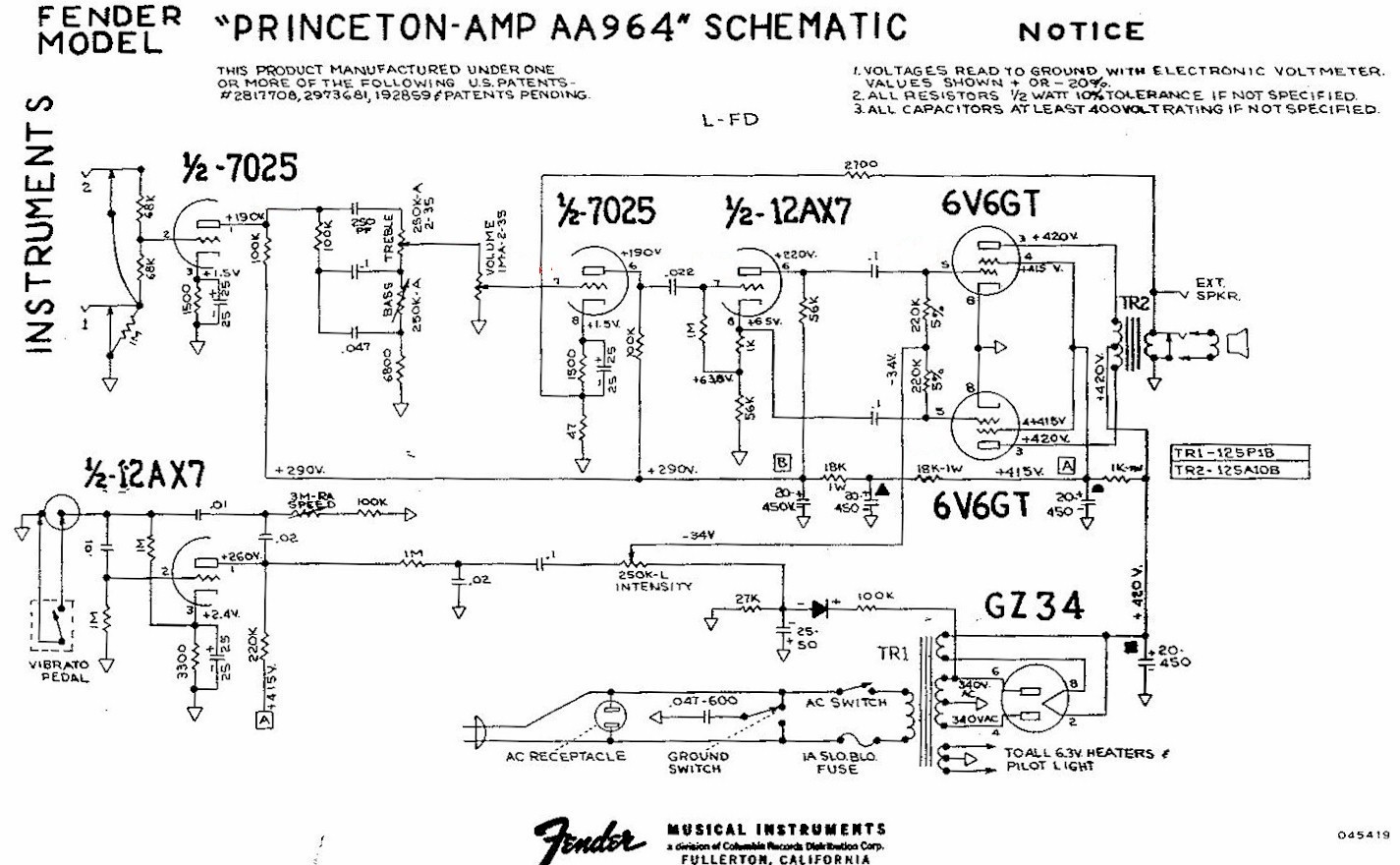
See the Princeton Reverb with reverb and tremolo deleted (simple to build amp with three preamp gain stages so it's very different than the blackface non-reverb Princeton)
See the Princeton Reverb Micro with reverb and tremolo deleted (1 watt 12AU7 true push-pull power tube)

